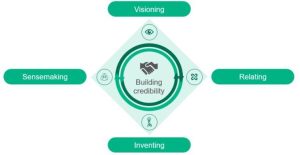A study conducted by McKinsey in 2015, analyzing 366 public companies, revealed that companies with diverse management teams were 35% more likely to achieve financial returns above their industry averages (Rock, 2016). Diversity, Equity, and Inclusion (commonly known as DEI) go far beyond being mere checkboxes. Unfortunately, the implementation of such strategies remains immature. Recent research indicates that only 51% of organizations have a structured DEI strategy, with merely 44% of them implementing actionable changes to their DEI initiatives (McCourt, 2023). Studies consistently demonstrate that diverse teams yield superior results, especially when they are well-led. This principle applies universally and can be integrated into any situation on any given day (CULCSOMJIK, 2014). Incorporating individuals from diverse backgrounds, disciplines, cultures, and generations is not merely a challenge to overcome but a necessity for building successful teams (Thomas, 2004).

The Power of Diversification
Diversification creates a wealth of perspectives, ideas, and skills that an organization can fully leverage. A diverse team allows members to draw inspiration and ideas from seemingly unrelated sources (FRANS & CLAIRE, 2023). One exemplary instance of such diversity is Singapore, a powerhouse in the Southeast Asian financial economy. The country excels in international rankings for diversity in education and business, resulting in its recognition as one of the world’s most technologically advanced countries (Eswaran, 2019). A particularly compelling case study is Nike’s Colin Kaepernick, whose merchandise sales generated a staggering $6 billion in revenue for the company (Abad-Santos, 2018). T-Mobile also learned that increasing diversification is not a sprint but a marathon. They discovered that diverse board teams helped disrupt old habits and establish new norms for their company (European Roundtable For Industries, 2020).
Effective Leadership
In the technological sector, leadership has historically been male-dominated. According to research by Statista, the percentage of female leaders in tech companies ranged from 8% to 14% between 2015 and 2022 (Statista Research Department, 2023; Anjali Shaikh, Kristi Lamar, & Ranjit Bawa, 2020). In this sector, companies are placing more emphasis on an indiv
idual’s ability to communicate and navigate the C-suite and vendor relationships rather than purely relying on paper qualifications. There is a growing demand for leadership skills among personnel (Anjali Shaikh, Kristi Lamar, & Ranjit Bawa, 2020).
Effective leadership in this context encompasses five key capabilities: Visioning, Relating, Inventing, Sensemaking, and Building Credibility. These
skills prioritize communication over technical knowledge (Ancona, 2018). Therefore, effective leadership is not about dominance but about embracing collaboration, transparency, and fostering a culture of trust and continuous growth (Carlton, 2023).

Overcoming the Challenges
Diversity in teams is significantly influenced by the principles of tolerance and sensitivity. The assumption of “just like me” is a general perspective that individuals often hold when they come together (Tapia, 2021). Diverse teams commonly face challenges such as miscommunication, cultural misunderstandings, inequitable inclusion, discrimination, and slow decision-making processes (Kallidus, 2023). Overcoming these challenges is possible through self-review, effective communication, creating a shared vision, promoting collaboration, and managing conflicts (LinkedIn, n.d.).
The technology industry thrives on connecting people, making collaboration a norm. With software tools that facilitate regulation and the integration of AI, the industry has the means to address diversity challenges (Herman, n.d.). However, the crucial factor lies in the users’ willingness to utilize these tools to manage and overcome conflicts effectively.
Inclusive Work Environment
In the technology sector, fostering an inclusive work environment has become paramount, especially in the post-Covid-19 era. The rise of remote work is a significant trend, driven by employees’ reluctance to relocate due to soaring rental costs and personal expenses (Wooll, 2021). Embracing this shift, technology plays a pivotal role in managing diversity and inclusion. It acts as a bridge, connecting people and resources seamlessly. With the integration of Artificial Intelligence, the process of fostering inclusivity becomes not only more effective but also mutually beneficial for both employees and employers, enhancing productivity and collaboration in innovative ways (Lagar, 2022).

Conclusion
Embracing diversity is not just a transient trend but a transformative strategy that confers a distinct competitive advantage to organizations. Enlightened leaders recognize the profound impact diverse teams can have on innovation and productivity, harnessing their varied perspectives, skills, and experiences. Through effective leadership, these diverse teams are integrated harmoniously, creating a dynamic work environment where creativity flourishes, and problem-solving reaches new heights. Such organizations, propelled by the richness of diversity, emerge as pioneers, setting new standards in innovation, productivity, and social responsibility. In this context, the significance of embracing diversity extends far beyond the workplace—it becomes a driving force shaping a progressive and inclusive society (Brennan).
References
Abad-Santos, A. (24 09, 2018). Nike’s Colin Kaepernick ad sparked a boycott — and earned $6 billion for Nike. Retrieved from Vox: https://www.vox.com/2018/9/24/17895704/nike-colin-kaepernick-boycott-6-billion
Ancona, D. (14 11, 2018). The Five Key Capabilities of Effective Leadership. Retrieved from Insead Knowledge: https://knowledge.insead.edu/leadership-organisations/five-key-capabilities-effective-leadership
Anjali Shaikh, Kristi Lamar, & Ranjit Bawa. (06 03, 2020). Paving diverse paths to technology leadership. Retrieved from Deloitte: https://www2.deloitte.com/us/en/insights/topics/value-of-diversity-and-inclusion/diversity-and-inclusion-in-tech/diverse-paths-to-technology-leadership.html
Brennan, J. (n.d.). A New Era Of CEOs: Embracing Diversity And Connectivity. USA: Forbes.
Carlton, C. (14 06, 2023). Effective Leadership: Fostering. Retrieved from Linkedin: https://www.linkedin.com/pulse/effective-leadership-fostering-collaboration-trust-growth-carlton/
CULCSOMJIK. (16 06, 2014). Research has consistently shown that diverse teams produce better results, provided they are well led. The ability to bring together people from different backgrounds, disciplines, cultures, and generations and leverage all they have to offer,. Retrieved from Leadership: https://culcsomjik.wordpress.com/2014/06/16/research-has-consistently-shown-that-diverse-teams-produce-better-results-provided-they-are-well-led-the-ability-to-bring-together-people-from-different-backgrounds-disciplines-cultures-and-gener/
David Rock, H. G. (04 11, 2016). Why Diverse Teams Are Smarter. Retrieved from Harvard Business Review: https://hbr.org/2016/11/why-diverse-teams-are-smarter
Eswaran, V. (29 04, 2019). The business case for diversity in the workplace is now overwhelming. Retrieved from World Economic Forum: https://www.weforum.org/agenda/2019/04/business-case-for-diversity-in-the-workplace/
European Roundtable For Industries. (2020). Inclusion and Diversity Case Study. Belgium: ERT.
FRANS, J., & CLAIRE , H. (01 06, 2023). Why Diverse and Inclusive Teams Are the Engines of Innovation. Retrieved from Great Place to Work: https://www.greatplacetowork.com/resources/blog/why-diverse-and-inclusive-teams-are-the-new-engines-of-innovation
Herman, M. (n.d.). 8 Types of Collaboration to Use in your Digital Workplace. Retrieved from lumapps: https://www.lumapps.com/employee-experience/types-of-collaboration/
Kallidus. (23 06, 2023). The top challenges of diversity in the workplace. Retrieved from Kallidus: https://www.kallidus.com/resources/blog/top-challenges-of-diversity-in-the-workplace/
Lagar, J. L. (02 08, 2022). THE ROLE OF TECH IN BUILDING A MORE INCLUSIVE ENVIRONMENT. Retrieved from Hexacta: https://www.hexacta.com/the-role-of-tech-in-building-a-more-inclusive-environment/
Linkedin. (n.d.). How do you overcome diversity challenges? Retrieved from Linkedin: https://www.linkedin.com/advice/0/how-do-you-overcome-diversity-challenges-skills-people-management
McCourt, M. (2023). Highlights from Our 2021 State of DEI Report. San Fransico: Lever.
Statista Research Department. (2023). Share of female leaders in tech companies worldwide from 2015 to 2022. Statista.
Tapia, A. (15 04, 2021). For Diversity to Work, Recognize Differences, Not Just Similarities. Retrieved from Korn Ferry: https://www.kornferry.com/insights/briefings-magazine/issue-21/viewpoint-diversity-work-recognize-differences-not-just-similarities
Thomas, D. A. (2004). Diversity as Strategy. Harvard Business Review, 9.
Wooll, M. (13 12, 2021). Diversity in tech: Closing the gap in the modern industry. Retrieved from Betterup: https://www.betterup.com/blog/diversity-in-tech



Interesting read
Totally agree with the undeniable importance of diversity and inclusive leadership in today’s business world. Singapore, Nike, and T-Mobile’s success stories show that embracing diversity and fostering an inclusive work environment are essential for innovation and sustained growth, especially in the tech industry.
“Your blog on the importance of diversification truly drives home the message that in today’s rapidly changing world, it’s not just a choice, but a necessity. Your eloquent explanation of how diversification can make a ‘world of difference’ is spot on.
Great article on The Power of Diversification with ethical leadership. The considerations of challenges within workplaces and ethicals indeed does invloved the contribution of ethical leadership. Looking forward to the next articles.
Great conclusion which highlighted the enduring significance of diversity as a transformative strategy.
Gabriel Sze’s article really drives home the idea that having a diverse bunch of folks in a company is super important. He’s got some fancy stats, like a study by McKinsey that shows how companies with a mix of people on their teams tend to make more money. And there are some cool stories about how this plays out in Singapore, where being diverse in education and business has helped make it a tech powerhouse.
The article also talks about leadership, especially in the tech world. It’s not all about fancy qualifications; they’re looking for leaders who can talk and work with others. They need to be good at things like communication and collaboration. And there are some tips on how to deal with the challenges that come with having a diverse team. In the end, the article says that being diverse isn’t just a business thing, it’s something that makes society better too.
Nice read. I like the statement ” principle applies universally and can be integrated into any situation on any given day ” this is like no barriers.
Unless a new barrier comes out somewhere
Well written blog. I totally agree with you that diversity extends far beyond the workplace!
Great conclusion, diversity indeed brings a lot of benefits, but achieving and sustaining diversity in leadership is a long and challenging journey.
Its well written!